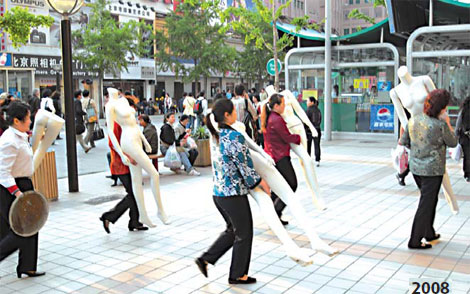|
|
 |
|
30th Anniversary Celebrations
New Rural Reform Efforts
Political System Reform
Changing Lifestyle
In Foreigners' Eyes
Commentary
Enterprise Stories
Newsmakers
Photo Gallery
Video and Audio
Wang Wenlan Gallery
Slideshow
Key Meetings
Key Reform Theories
Development Blueprint
Liu Shinan:
Don't go too far in name of sex education Hong Liang:
US should fix its own economic woes first Chen Weihua:
Need for medical privacy OP Rana:
This world dream can't be deferred Ready-to-wear
By You Nuo (China Daily)
Updated: 2008-11-10 13:51    Made-in-China garments and textiles may still be favored items for middle-class shoppers during the current financial crisis. But while choosing between the large quantities and varieties of domestic supplies, perhaps very few can remember that 30 years ago China was nicknamed the country of "blue ants" in the international press. The reference was to the teeming masses of Chinese citizens seemingly all clad in ubiquitous blue trousers and jackets. That was a time when few billboards existed, except for those with political slogans. Shop windows usually had few items on display, and certainly not for fashion. Chinese cities actually had only one basic clothing style. That has been well-documented, though not statistically, but by thousands of old photos including ones that have run in this column. It took around two decades, between the 1980s and '90s, for urban Chinese to revamp their wardrobes. And indeed that was the time when many families began to own their first colorful wardrobes. Even farmers threw away their old clothes made from black coarse cloth cut from the pre-industrial age. Commercial campaigns for fashion began to spread in the cities - from the large coastal ones to the smaller ones in the inland areas. At the time our black-and-white photo was taken, this country was growing into one of the major exporters of (mainly inexpensive) garments and textiles in the world. But the change was not just an increase in production or variety. It is not just a success story of an industry. The flourishing garment market was an example of the spread of all sorts of commercial operations and how much difference they made. There may not seem much of a relationship from importing fashion shows, as shown in our black-and-white photo taken in 1999 - which must have been one of the earliest ones in the country - to sales staff carrying plastic mannequins across the street as seen in our 2008 color photo. From a marketing point of view, the fashion shows that feature international models are rare, glitzy events that take place in expensive locales. Whereas constantly re-arranging displays in shop windows and putting out temporary demonstrations on sidewalks, as people in the 2008 photo might be doing, shows the world of ordinary shops and consumers. The two photos show both ends of a learning process which originates in the metropolitan centers and permeates daily life with an offer to appreciate more choices. But it is far from complete yet. It was only recently, for instance, that the concept of branding began to sow its seeds in Chinese society. The Chinese still don't own many international garment brands yet.
 
 |
主站蜘蛛池模板: 久久悠| a毛片免费全部播放完整成 a毛片免费全部在线播放毛 | 在线播放成人高清免费视频 | 中文字幕一区二区三区精彩视频 | 免费高清一级欧美片在线观看 | 国产日产精品_国产精品毛片 | 久草在线资源视频 | 日本三级香港三级少妇 | 国产精在线 | 精品久久久久国产免费 | 国产盗摄一区二区 | 亚洲精品专区一区二区欧美 | 色欲麻豆国产福利精品 | 亚洲影视一区二区 | 亚洲精品久久一区影院 | 亚洲经典在线 | 新版天堂中文资源官网 | 免费人成年短视频在线观看网站 | 亚洲精品视频区 | 国产高清毛片 | 亚洲国产三级在线观看 | 91成人免费观看在线观看 | 日本久久久久久久 | 久久精品国产第一区二区 | 午夜男人女人爽爽爽视频 | 日韩日韩日韩手机看片自拍 | 97免费视频免费视频 | 久久成人精品视频 | 成年人国产 | a级毛片免费观看网站 | 久久久久久中文字幕 | 亚洲久久视频 | 欧美成人精品大片免费流量 | 亚洲欧美卡通成人制服动漫 | 免费精品99久久国产综合精品 | 国产欧美久久久另类精品 | 视频在线一区 | 欧美最刺激好看的一级毛片 | 粉嫩高中生的第一次在线观看 | 国产成人精视频在线观看免费 | 毛片免费观看日本中文 |